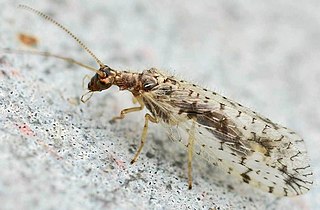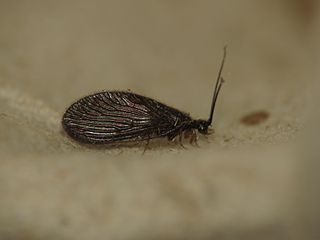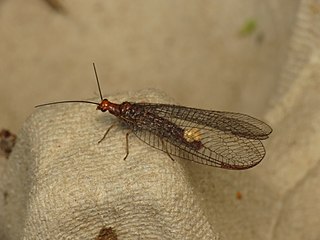
The insect order Neuroptera, or net-winged insects, includes the lacewings, mantidflies, antlions, and their relatives. The order consists of some 6,000 species. Neuroptera is grouped together with the Megaloptera and Raphidioptera (snakeflies) in the unranked taxon Neuropterida.

Green lacewings are insects in the large family Chrysopidae of the order Neuroptera. There are about 85 genera and 1,300–2,000 species in this widespread group. Members of the genera Chrysopa and Chrysoperla are very common in North America and Europe; they are very similar and many of their species have been moved from one genus to the other time and again, and in the nonscientific literature assignment to Chrysopa and Chrysoperla can rarely be relied upon. Since they are the most familiar neuropterans to many people, they are often simply called "lacewings". Since most of the diversity of Neuroptera are properly referred to as some sort of "lacewing", common lacewings is preferable.

Hemerobiidae is a family of Neuropteran insects commonly known as brown lacewings, comprising about 500 species in 28 genera. Most are yellow to dark brown, but some species are green. They are small; most have forewings 4–10 mm long. These insects differ from the somewhat similar Chrysopidae not only by the usual coloring but also by the wing venation: hemerobiids differ from chrysopids in having numerous long veins and forked costal cross veins. Some genera are widespread, but most are restricted to a single biogeographical realm. Some species have reduced wings to the degree that they are flightless. Imagines (adults) of subfamily Drepanepteryginae mimic dead leaves. Hemerobiid larvae are usually less hairy than chrysopid larvae.

The Neuropterida are a clade, sometimes placed at superorder level, of holometabolous insects with over 5,700 described species, containing the orders Neuroptera, Megaloptera, and Raphidioptera (snakeflies).

Psychopsidae is a family of winged insects of the order Neuroptera. They are commonly called silky lacewings.

Allorapisma is an extinct genus of lacewing in the moth lacewings family Ithonidae. The genus is solely known from two Eocene fossils found in North America. At the time of description the genus was composed of a single species, Allorapisma chuorum.

Ithonidae, commonly called moth lacewings and giant lacewings, is a small family of winged insects of the insect order Neuroptera. The family contains a total of ten living genera, and over a dozen extinct genera described from fossils. The modern Ithonids have a notably disjunct distribution, while the extinct genera had a more global range. The family is considered one of the most primitive living neuropteran families. The family has been expanded twice, first to include the genus Rapisma, formerly placed in the monotypic family Rapismatidae, and then in 2010 to include the genera that had been placed into the family Polystoechotidae. Both Rapismatidae and Polystoechotidae have been shown to nest into Ithonidae sensu lato. The larvae of ithonids are grub-like, subterranean and likely phytophagous.

Chrysoperla is a genus of common green lacewings in the neuropteran family Chrysopidae. Therein they belong to the Chrysopini, the largest tribe of subfamily Chrysopinae. Their larvae are predatory and feed on aphids, and members of this genus have been used in biological pest control.

Chrysopinae is the nominate subfamily of green lacewings in the insect family Chrysopidae in the order Neuroptera. This subfamily is also the largest within the family and comprises about 60 genera.

Kalligrammatidae, sometimes known as kalligrammatids or kalligrammatid lacewings, is a family of extinct insects in the order Neuroptera (lacewings) that contains twenty genera and a number of species. The family lived from the Middle Jurassic to the early Late Cretaceous before going extinct. Species of the family are known from Europe, Asia, and South America. The family has been occasionally described as "butterflies of the Jurassic" based on their resemblance to modern butterflies in morphology and ecological niche.
Rafaelnymphes is an extinct genus of lacewing in the family Nymphidae known from a fossil found in South America. The genus contains a single species, Rafaelnymphes cratoensis.

Sympherobius is a genus of brown lacewings in the family Hemerobiidae. There are at least 50 described species in Sympherobius.

Sisyra is a genus of lacewings in the family Sisyridae. There are at least 8 described species in Sisyra.

Chrysopini is a tribe of green lacewings in the family Chrysopidae. There are about 32 genera and 926 described species in Chrysopini.
Eremochrysa is a genus of shadow lacewings in the family Chrysopidae. There are about 18 described species in Eremochrysa.

Abachrysa is a genus of green lacewings in the family Chrysopidae. There is one described species in Abachrysa, Abachrysa eureka.

Nothochrysa is a genus of green lacewings in the family Chrysopidae. There are about 10 described species in Nothochrysa.

Leucochrysa is a genus of green lacewings in the family Chrysopidae. As of 2013, there are 196 described species in Leucochrysa.
Yumachrysa is a genus of green lacewings in the family Chrysopidae. There are at least four described species in Yumachrysa.

Protobiella zelandica is a species of New Zealand beaded lacewing in the family Berothidae that was first described by Robert John Tillyard in 1923. It is the sole known species in the genus Protobiella, and the only berothid endemic to New Zealand. No subspecies are noted in the Catalogue of Life.

















